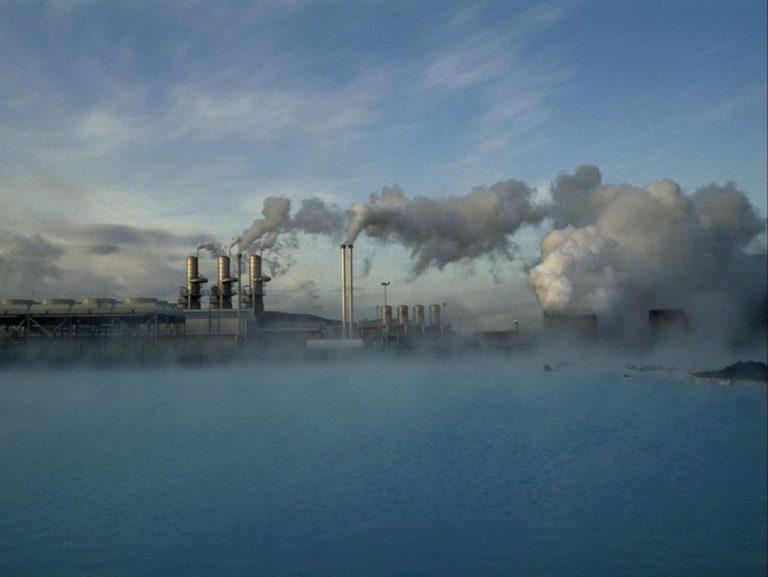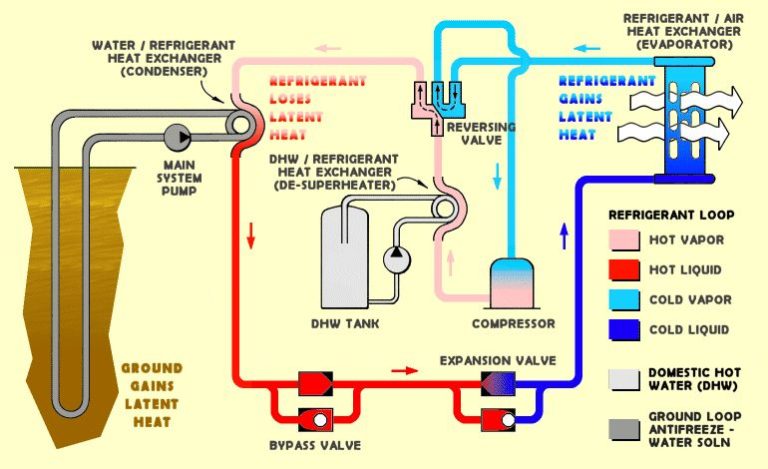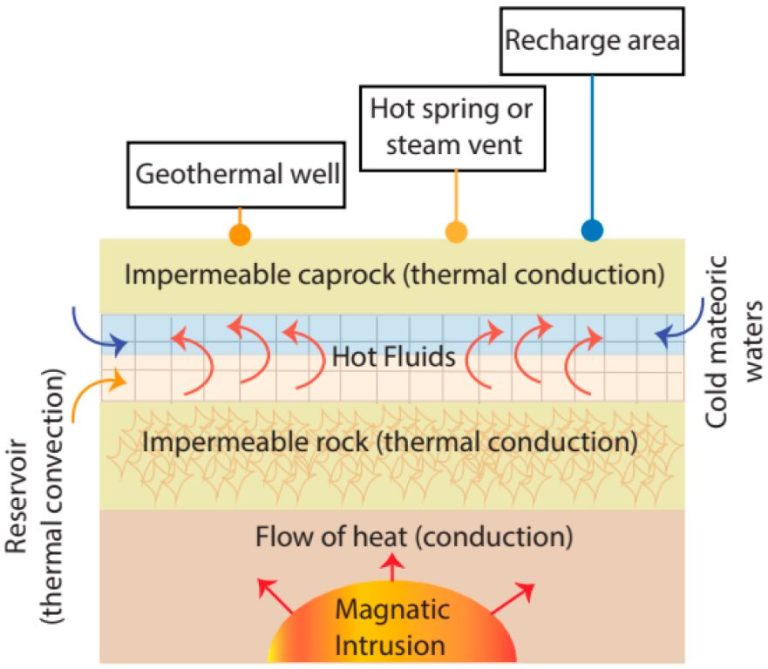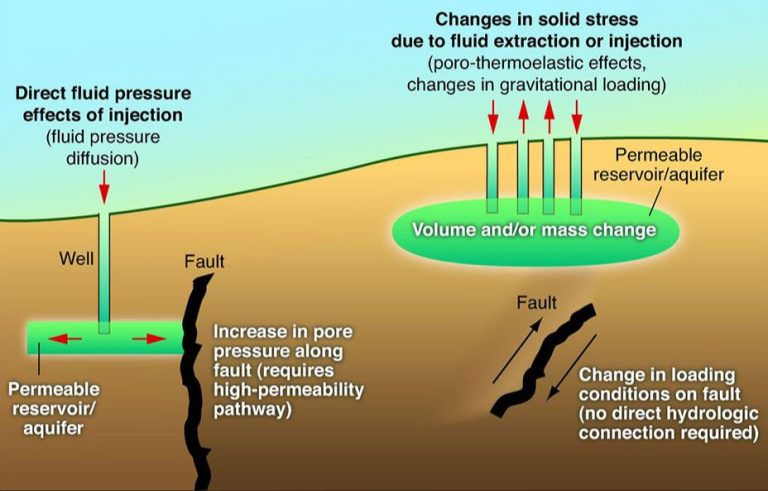Is Geothermal Energy Good For Homes?
What is geothermal energy?
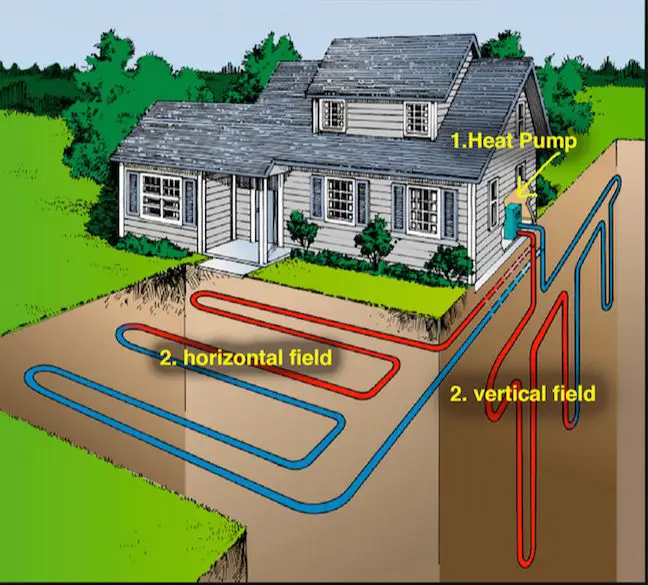
Geothermal energy is heat energy generated and stored in the Earth (Geo (earth) + thermal (heat)) [1]. It is a renewable energy source that takes advantage of the constant temperature in the Earth’s interior to provide heating and cooling. The geothermal gradient means that temperature increases with depth – on average by 25-30°C per km. This heat can be accessed by drilling water or steam wells in areas where temperatures are suitably hot to generate energy.
There are three main types of geothermal energy systems that take advantage of the earth’s heat:
- Direct use and district heating systems use hot water from springs or reservoirs near the surface.
- Electricity generation plants extract both heat and water from areas with temperatures usually above 150°C.
- Ground source heat pumps use shallow ground heat for space heating and cooling in buildings.
In each case, geothermal energy is generated by tapping into underground reservoirs of hot water to produce energy without burning fossil fuels. This makes it a renewable and sustainable energy source.
Benefits of geothermal for homes
Geothermal systems are significantly more efficient than conventional HVAC systems. According to IAQ Colorado, geothermal heat pumps can be over 45% more efficient than even the highest-rated air conditioners and furnaces. This increased efficiency translates into lower energy usage and utility bills. Geothermal systems use 25-50% less electricity than conventional systems, providing homeowners substantial cost savings.
In addition to lower energy usage, geothermal systems have a reduced carbon footprint. They emit little to no greenhouse gases, unlike systems that burn fossil fuels. Geothermal energy is considered a renewable and sustainable technology. Systems last 20-25 years on average, with some operating efficiently for over 50 years with proper maintenance.
Geothermal systems can also be conveniently paired with solar photovoltaic systems. The geothermal system provides heating and cooling, while the solar PV system generates electricity. Together, they can provide a home with most or all of its energy needs sustainably.
Potential Drawbacks of Geothermal for Homes
Although geothermal energy has many benefits, there are some potential drawbacks to consider before installing a geothermal system in your home:
High Upfront Costs – Installing a geothermal system requires drilling wells and installing the geothermal loop, heat pump unit, and ductwork which can cost $20,000-$30,000 upfront. This is significantly more expensive than installing a traditional HVAC system.
Limited Feasibility – Geothermal systems require access to underground space for the ground loop, so they are not feasible everywhere, especially in dense urban areas. You also need adequate land space for the drilling equipment.
Potential Leaks – Though rare, leaks in the underground piping can lead to loss of efficiency and higher operating costs. Proper installation and maintenance is key to prevent leaks.
While geothermal systems have higher upfront costs, the energy savings over their lifespan often make them a wise long-term investment. But the location requirements may limit feasibility for some homes.
Cost comparison to traditional HVAC
The average installation cost for a geothermal system is between $17,000 and $25,000 according to Forbes. This is considerably higher than the average cost of installing a traditional HVAC system, which ranges from $5,000 to $12,000. However, geothermal systems can provide significant savings over time.
According to Angi, geothermal systems generally cost around 30-60% less to operate each year compared to conventional HVAC systems. The reason is that geothermal systems use the stable temperatures underground, which is far more efficient than traditional systems that rely on the outdoor air temperature. This results in lower electricity bills for heating and cooling.
The return on investment timeline for a geothermal system is generally 5-10 years. After this period, the homeowner begins realizing substantial lifetime savings. Geothermal systems also have a lifespan of 25 years for the heat pump itself and 50+ years for the ground loop system. This makes them a cost-effective choice over the long run.
Ideal Home Situations for Geothermal
The ideal home situations for installing a geothermal system are homes that meet certain criteria in terms of size, climate, and soil type.
Home Size: Geothermal systems work best for homes that are over 2,500 square feet. The larger the home, the more cost effective a geothermal system will be (source). This is because the high upfront costs can be distributed across higher energy savings.
Climate: Homes in extreme climates – both very hot and very cold – are good candidates for geothermal systems. The systems can handle wide temperature variations efficiently. Homes in temperate climates may not benefit as much (source).
Soil Type: The best soil type for geothermal is dry soil that transfers heat well, like sand or gravel. Wet soil or solid rock are less conductive. Homes need adequate land space for the buried loops that transfer heat to/from the soil (source).
Federal Tax Incentives
The federal government currently offers a 26% tax credit for installing a qualified geothermal heat pump in a residential home through December 31, 2032. This tax credit can be claimed on both existing homes and new construction. According to the Energy Star website, there is no limit to the amount that can be claimed for geothermal systems. The geothermal system must meet Energy Star requirements and be installed by a qualified technician.
In addition to federal incentives, many states and utilities offer rebates or other incentives for installing a geothermal system. For example, WaterFurnace notes that states like Maryland, New York, Oregon, and Virginia offer state tax credits ranging from 15-30% of the total system cost. Checking with your state energy office and local utility is recommended to find any available incentives or rebates to help offset the upfront cost of a geothermal system.
Environmental impact
Geothermal systems have a significantly lower carbon footprint compared to conventional HVAC systems that rely on fossil fuels like natural gas or heating oil. According to the U.S. Department of Energy, geothermal heat pump systems can reduce energy consumption and corresponding emissions by 23% to 44% compared to air-source heat pumps and by 63% to 72% compared to electric resistance heating with standard air-conditioning equipment [1].
Unlike fossil fuel plants, geothermal systems do not directly burn fuels to generate heat or electricity. However, a small amount of carbon dioxide and sulfur dioxide can be released from geothermal reservoirs. Even factoring in these emissions, the carbon footprint of geothermal energy is much lower per kWh compared to coal and natural gas [2].
In terms of long-term sustainability, geothermal resources are considered renewable and sustainable if managed properly. Geothermal fields can provide consistent heat for decades with minimal decline if the rate of fluid extraction is balanced by the rate of natural recharge and replenishment of the reservoir [1]. Ongoing monitoring can help ensure geothermal systems have minimal environmental impact over their operating lifetime.
Maintenance Requirements
While geothermal systems generally require less maintenance than traditional HVAC systems, some regular upkeep is still necessary for optimal performance. According to Clarke-Rush (https://clarke-rush.com/basic-geothermal-heat-pump-maintenance/), it’s important to regularly replace the air filters. Clogged or dirty filters reduce airflow and efficiency. Most experts recommend changing filters every 1-3 months. The outdoor unit coils should also be cleaned annually to remove any built-up debris. Checking antifreeze levels in the loop pipes each year and topping off as needed is also advised.
Potential repairs may include fixing leaks in the buried loop piping, recharging the refrigerant, or replacing a broken pump or fan motor. The underground pipes are usually very durable, but if a leak develops it can be difficult to locate and repair. Typical service calls average $150-$300, but pipe repairs or replacements can cost thousands. According to Sobieski Inc. (https://www.sobieskiinc.com/blog/6-easy-tips-handle-geothermal-system-maintenance/), following the manufacturer’s maintenance recommendations can help minimize repairs.
Future outlook
The future looks bright for geothermal energy. According to the MIT report, global geothermal power capacity is projected to grow over 26-fold from 2015 to 2050. With improved technology, the geothermal resource base could expand by 5 to 10 times. Enhanced geothermal systems (EGS) could enable geothermal energy production almost anywhere in the world.
Advances in drilling technologies and geosciences will open up new geothermal resources. The U.S. Department of Energy is investing in projects to demonstrate EGS feasibility and improve techniques for accessing geothermal reservoirs. New technologies like advanced cements and nanomaterials show promise for withstanding harsh geothermal environments.
Conclusions
In summary, geothermal energy has several notable pros and cons for homeowners to consider. On the pros side, geothermal systems provide consistent heating and cooling, have lower operating costs than conventional HVAC systems, last longer with lower maintenance requirements, and have a lower carbon footprint. The upfront installation cost is quite high, potentially twice as much as installing a traditional system. Geothermal works best for homeowners who plan to stay in their home long-term to recoup the installation investment. Homeowners with available land for digging ground loops will benefit most from the cost savings. Overall, geothermal energy is a smart, eco-friendly HVAC option for homeowners who can manage the high upfront costs and want to maximize long-term savings and environmental benefits.
For homeowners deciding whether to install geothermal energy, the recommendation would be to thoroughly research upfront installation costs in your area, determine if digging ground loops is feasible on your property, calculate projected operating cost savings to determine your breakeven point, and evaluate if you plan to stay in the home long enough to realize those savings. Geothermal provides optimal benefits for homes that can utilize ground loops over pond loops, have high and consistent heating/cooling demands, and seek the highest efficiency with the lowest environmental impact. While not ideal for every home, geothermal energy can provide significant benefits for the right homeowner.

